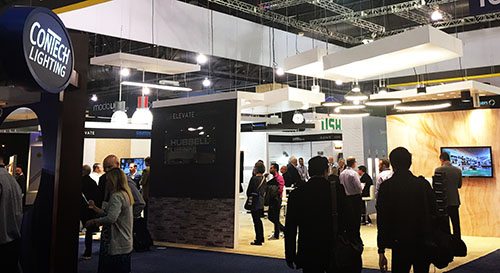By Kyle Christensen (LC), Border States Construction Market Specialist

PHILADELPHIA, Pa. – On behalf of Border States, I traveled here the week of May 8 for Lightfair International 2017, the world’s largest annual architectural and commercial lighting trade show and conference. Check out the interesting trends I gathered from participating manufacturers:
Superior optical control
Instead of focusing on efficiency or efficacy, many of the major lighting manufacturers played up their ability to more effectively guide lumens and improve visual comfort through superior optics.
It sounds like marketing fluff, but I could really tell the difference between the manufacturers who had optical control and those who didn’t as I traveled between the booths.
Eaton’s Cooper Lighting was a standout for optical control again this year. They’ve been refining their WaveStream LED technology since 2013 and they now have a well-rounded product offering of powerful LED fixtures without glare. WaveStream works by edge-lighting a pane of optical acrylic with thousands of tiny, molded prisms, which softly redirect light in a desired direction.
Products displayed at Lightfair included troffers, suspended direct/indirect lighting, high bay, parking garage lighting and surface mount downlights.
Fixture aesthetics
More than ever before, LED manufacturers are starting to care what a fixture looks like when it’s turned off.
Decorative lines have always been associated with the look of a fixture, but this year even traditionally “white goods” manufacturers like Westinghouse had some cool decorative pieces at the conference.
Along the same lines, many manufacturers are beginning to embrace the point-source nature of LED as heat sinks and drivers become more compact. This year’s recessed lighting products featured openings of 3 inches or less, so that a fixture disappears into a ceiling. Similarly, several indoor and outdoor product categories are moving toward edge-lit or concealed-source LED technology, to reduce glare.
No more binning
In the early days of LED, chip manufacturers would grow LEDs and categorize them into dozens of bins based upon output color. Fixture manufacturers would then figure out combinations of bins to create the desired color temperature (Ex. 4000 K) using multiple chips from different bins.
Today, phosphors and LED technology have advanced such that binning isn’t as critical as it used to be.
One example of this is GE Lighting’s Reveal Tri-Gain phosphor technology. Tri-Gain is a fully synthetic phosphor combination that results in higher color-rendering (CRI), vivid reds (R9) and improved efficacy (lumens per watt). GE is offering this technology in many of its retail segment luminaires, with plans to expand the offering to more categories this year.
Future-proofing
I noticed several advancements toward future-proofing LED fixtures, which seems logical given that most of them now have a life expectancy of 10-plus years. One such concept that many manufacturers have embraced is modularity, the ability to reconfigure the fixture in the field and/or add standardized components to it at a later date. For example, Dialight LED industrial fixtures can be ordered with Rockwell Automation compatibility today, but there are plans to redesign some of the fixtures this year to accept other controls solutions at a later date in the field.
Fixtures with accessible, serviceable components are becoming more prevalent, too. Five years ago, fixtures needed to remain sealed (non-serviceable) to keep heatsinking and IP functions intact. (Otherwise, LED life may have been shortened.) Today, LED technology has advanced such that a driver with a mere 50,000-hour life is the most likely component to fail first.
A study done by Appalachian Lighting Systems, Inc., showed that the most likely reasons for LED luminaire failures were:
- Driver (Power Supply) 52 percent
- Housing 31 percent
- LED Package 10 percent
- Driver (Control Circuit) 7 percent
As life expectancies and LED product life cycles continue to grow, I anticipate that field-serviceable luminaires will continue to become more mainstream.
Dimming is expected, still not standardized
Even among second- and third-tier manufacturers, dim-to-warm seems to be the new normal for recessed LED trims. The intent is to mimic the incandescent sources that consumers are used to by decreasing the color temperature (lower CCT means more amber) as the light output is reduced. However, the industry is still wrestling with how to compensate for the differential between actual and perceived light output of a dimmed LED source. Studies have shown that LEDs dimmed to 10 percent energy levels still appear to be about 30 percent brightness to the human eye. Dim-to-warm technology helps, but it still isn’t quite what the incandescent consumer is used to.
I was surprised that there didn’t seem to be any significant advancements in LED dimming this year. A 0-10V protocol remains dominant among fixture manufacturers, but exactly how the fixture reacts to the control signal still varies widely between dimmer and driver combinations. LED lamp compatibility with leading-edge (TRIAC) and trailing-edge (ELV) dimmers is still a shot in the dark. Further, the manufacturers that are getting into color-tuning still haven’t agreed whether to control it with DMX, DALI or some other digital format. The industry is still far from standardization.
Final thought: Bridge to connected lighting
Philips Lighting featured a big color-changing bridge at their booth, which I think was symbolic of where the lighting industry seems to be right now. We know that lighting is capable of doing much more than just illumination, but exactly how we make the leap to connected lighting and the internet of things (IoT) is still being worked out. In the meantime, we are working to make the journey more pleasant through improved optical control and aesthetically pleasing designs with an eye on future-proofing today’s installation for the needs of tomorrow.